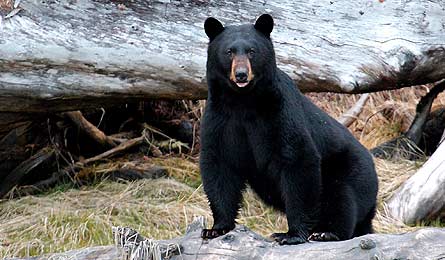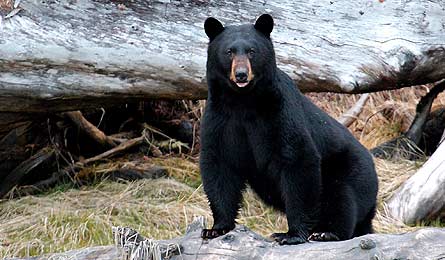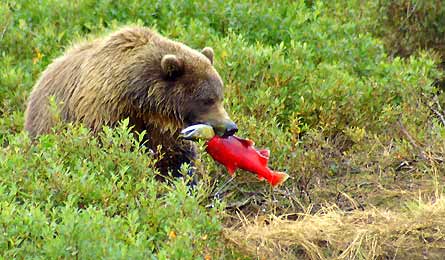Learn to Survive a Bear Attack

'Black bears are prominent throughout North America. (John Jacques)'

Black bears are prominent throughout North America. (John Jacques)

A grizzly bear snacks on a salmon. (Javier Martinez)
Know Your Bruin
Black bear – First off, they’re not always black—they can be brown and even blond. So look for their big, velvety ears, long, pointy snout, and (if viewing through binocs) short, curved claws. Two to four feet tall at the shoulder (four to six when standing) and weighing between 110 and 400 pounds, black bears live in wooded areas throughout North America, with the densest populations in New England, Canada, the Rockies, and the Pacific West.
Grizzly bear – The king of the wild reaches three to four feet tall at the shoulder and more than six to eight when standing. Weighing between 350 and 1,200 pounds, grizzlies—aka, Kodiaks when in Alaska’s Kodiak region and brown bears when on the coast—range from black to blond and have a long snout, a big hump between their shoulders, long front claws, and short, fuzzy ears. While you may see a grizzly in the U.S. (especially Alaska, Idaho, Montana, Washington, and Wyoming), they mostly inhabit Western Canada, living predominantly on prairies and in open fields. Even the bears that ramble atop mountains wander down to lower areas to feed. “They’ll cover a huge area—as far as 200 miles—to find food,” Rogers says.
Rare Encounters
Ghost bear(aka, spirit bear or Kermode bear) – This is a black bear with a recessive gene that turns its fur white—an evolutionary trick for catching fish. Scientists believe the color blends with the sky so salmon don’t know they’re being stalked. Looking for one? Head to British Columbia, the only place they live.
Pizzly bear – A cross between a polar bear and a grizzly, the pizzly is extremely rare. One was shot in April 2010 (allegedly by accident; hunting them is illegal) on Canada’s Victoria Island.
Glacier bear – This black bear in southeast Alaska has bluish-gray fur over its entire body.
Assess the Risk
Statistically, it’s way less than you think. Since 1900, black bears have killed 65 people and grizzlies 57. To put that in perspective, lightning claimed 28 lives in 2008 alone. As cliché as it sounds, “bears are probably more afraid of you than you are of them,” Rogers says, and want to avoid you. But with dwindling wilderness, that’s harder to do. So while you shouldn’t let bear-phobia keep you tossing in your sleeping bag, keep a safe distance and protect camp food (read on for tips on both).
Stay Alert in Bear Hot Spots
This lets you avoid startling a bear while also affording you a prime photo op. Here is when and where you’re most likely to see them:
>> Dawn and dusk Although bears are active at all times of the day, this is when you’re most likely to see them out and about.
>> In the fall This is when they gorge themselves silly—called hyperphagia—to store fat for hibernation from October through March. But don’t assume all bears are hibernating. Some emerge to dig under the snow for food, and in the South, black bears stay out year-round.
>> Food-rich areas Since bears are ruled by their stomachs, you’ll find them at nature’s buffet tables: berry patches, forests laden with hazelnuts, beechnuts, or acorns, clamming areas, near carrion, and salmonspawning areas.
>> Avalanche chutes and trails Bears enjoy easy travel just like us.
>> In the silence Bears probably will hear or smell you before they see you. To help avoid surprising one (especially if you’re downwind), make noise: Talk, clap, sing, jingle bells (in some areas, bears have learned to associate metallic sounds with people).
Identify Bear Signs
Scat
Since bears are omnivores, their scat resembles that of a large dog but is full of seeds, berries, roots, and other plants—and sometimes animal parts. Bears go through periods when they feed mostly on meat, like carrion and young ungulates. This usually occurs in the spring, when few food options are available; the protein also adds bulk to their lean, post-hibernation bodies. Grizzlies will defend food caches, so tread carefully around carrion. If the scat is black, runny, and contains lots of fur, it’s likely from a wolf, since bears tend to skin prey to avoid the fur.
Tracks
Grizzly paws leave long claw prints while black bears don’t. Their front paw tracks measure 6” to 8’’ long (5” to 8.75” wide) and the hind tracks (shown above) measure 12” to 16” long (4.5” to 8.5” wide). A black bear’s tracks measure about 4.5” long (3.25” to 6” wide) in the front and 7” long (3.5” to 6” wide) in the rear (shown above).
Horizontal bite marks and vertical scratches five to seven feet up on trees
Bears rub against the marks, which hold scent. “Other bears can tell the sex, identity, and mood of the bear from the marking,” says Rogers.
Excavated earth
Grizzlies (and to a small extent black bears) dig in the dirt to look for small animals and roots.
Navigate a Close Encounter
First, don’t panic. Easy to say, we know, but the bear might not be attacking. Most of the time, it will saunter off. “Even when it pounces forward, slaps the ground, or blows air, it actually means the bear is nervous and won’t attack,” Rogers says. “In 40 years of being around wild black bears, I’ve seen that behavior a lot and never had one come after me.” But if a face-off is, indeed, underway, follow these pointers. And rehearse them in advance (your partner can play the bear).
Black bear
The best defense is to carry a pepper spray like Halt! Dog Repellent ($8, halt.com). Though marketed for dogs, Rogers says it’s strong enough to fend off a black bear. It shoots a stream about 15 feet, rather than a mist that can blow back into your face. If the bear comes after you (or is rummaging in your food), aim at its forehead and arc down. “I’ve squirted myself in the eye,” says Rogers, “and there’s no lasting harm. It teaches them a lesson: Campgrounds are no place for a bear.” Otherwise, a “nuisance” bear could be killed later by wildlife managers or a camper with a gun. If you don’t have spray, throw rocks and talk loudly in a deep voice. To appear bigger, grab a camp chair or sleeping bag and hold it over your head. “Doing just about anything aggressive will scare it away,” he says. If the bear does attack, your reaction depends on the circumstances:
>> Predatory In rare cases, black bears have, for unknown reasons, stalked and attacked people. In this scenario, don’t play dead or run (black bears and grizzlies can sprint at 35 mph). Rather, “Fight back with any weapon available: fists, feet, sticks, rocks, whatever,” he says.
>> Defensive “If it’s an even rarer attack by a mother defending cubs, which black bears hardly ever do, drop into the fetal position, since lying still has proven effective time and again,” Rogers says.
Grizzly
Again, pepper spray is your best option, but you’ll need a stronger brand, like Bear Deterrent from Counter Assault ($45, counterassault. com). If the bear makes contact anyway (like with a mother protecting cubs), lie in a fetal position, torso facing the ground, hands around neck. A curious bear might flip you. If so, keep rolling until back on your belly. Playing dead fails? Fight back with all you have.
Protect Your Food
Bears have remarkable noses. “I once monitored a bear who sniffed out a hazelnut crop 40 miles away,” Rogers says. “Two days later, she was there chowing down.” Ergo, in bruin-populated areas, store your food, garbage, and other odiferous items—clothes with food stains, sunscreen, toothpaste, lotion, bug dope, fuel (yes, really)—inside airtight bags, then keep the bags safe with one of the following methods.
>> Use bear canisters Rogers recommends the Backpackers’ Cache canister ($65; 2.7 lbs.; backpackerscache.com). Place the canister about 100 adult steps downwind from camp in case odors leak. Note: Many national and state park visitor centers rent—and, in some cases, require—canisters.
>> Hang a bag In places with less bear activity, where the weight of a canister isn’t justified, a bear bag can suffice, though experts disagree on their effectiveness: Some say an ambitious-enough black bear can always reach them. But since properly hung bags also keep out rodents and other critters, they’re a good idea in either case. Choose a tree 100 yards downwind from your tent, then attach your food bag to one end of 100-foot nylon cord. Tie a one-pound rock to the other end, toss it over a large branch, hoist the bag, and secure the line. You want the bag 10 feet off the ground and four feet from the trunk. View a step-by-step demo at backpacker.com/hangabearbag.
>> Set up a fence Surrounded by grizzlies? Keep them away by enclosing your campsite with a portable electric fence, like the one from UDAP ($250; 3 lbs. 8 oz., with batteries; udap.com). The wireand- mesh fence easily stakes into the ground in about 10 minutes, encloses a 27-by-27-foot area, and delivers 6,000 volts via two D-cell batteries—just enough shock to make any animal (including you) jump back, but not enough to inflict lasting damage.